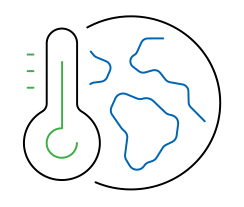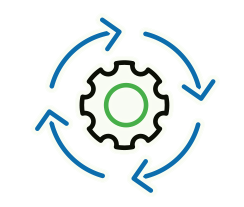Risks and Opportunities
Mitigating new-age challenges
At Marico, we have a well-established mechanism for risk management that straddles both the external environment and internal processes. The unique circumstances of the times have made it imperative to revisit the mechanism.
We believe that by reimagining the risk mitigation strategy, we will be able to lead with greater agility, efficiency and be able to deliver materially improved outcomes.


The identification, assessment and mitigation of risks is a perpetual enterprise-wide process and an irreplaceable part of our long-term strategic thinking. Our risk management framework covers strategic, financial, operational and ESG risks, as we aim to consistently create value and build a sustainable future for all stakeholders. We believe that the importance of embedding this discipline in the business culture of the organisation cannot be overemphasised, especially in the VUCA world that we operate in today.
Pawan Agrawal Chief Financial Officer
The COVID-19 pandemic has ushered in newer dimensions of risks, pushing organisations to recalibrate their risk mitigation strategy. As part of this transformed business focus, it has become imperative for us at Marico to embed strategic, financial and non-financial risk mitigation in all aspects of our business strategies and transformation agenda.
Marico’s risk management process, therefore, strives to analyse all significant business processes across the value chain keeping in mind the following types of risks:

Strategic
risk

Compliance and
Governance risk

Financial
risk

Environmental
risk

Operational
risk

Social
risk
Risk Management Committee (RMC)
Comprises Chairman of the Board, Managing Director and CEO, and the Chief Financial Officer
Assists the Board and Audit Committee
Material risks are reviewed annually by the RMC
Manages risks both at strategic and operational level
Risk Management Framework

Identify
Identify top risk for each function/business unit level

Quantify
Rate the risks on ‘impact’ and ‘vulnerability’ factors Prioritise top 10 risks at the Company level

Plan
Develop mitigation
plan for each risk
with relevant efforts
and result metrics
Recommend the
plan to the Board for
approval

Implement
Implement the risk mitigation plan

Monitor
Examine whether the mitigation plans are on track. Periodically review the existing risks and related metrics
 |
Strategic Risks |
MITIGATION STRATEGY |
STAKEHOLDERS IMPACTED |
CAPITALS IMPACTED |
||||||||
|---|---|---|---|---|---|---|---|---|---|---|---|---|
Changing consumer preference Demand can be adversely affected due to shift in consumer preferences, especially those induced by the pandemic. Given the potential of social media, the speed of such a shift could be unparalleled. |
|
|
|
|||||||||
Competitive market conditions Increase in the number of competing brands in the marketplace, counter campaigning and aggressive pricing by competitors could create a disruption. |
|
|
|
|||||||||
Underperformance of new product launches The success rate of new product launches in the FMCG sector is typically low. New products may not be accepted by the consumer or may fail to achieve the sales target. This risk is even more pronounced in cases where industry leaders invest in creating new categories. |
|
|
|
|||||||||
Private labels Expansion of modern trade and e-commerce could lead to the emergence of private labels. |
|
|
|
 |
Financial Risks |
MITIGATION STRATEGY |
STAKEHOLDERS IMPACTED |
CAPITALS IMPACTED |
||||||||
|---|---|---|---|---|---|---|---|---|---|---|---|---|
Volatility in interest rates Though the FMCG sector is not capital intensive, fund requirements arise on account of inventory position building, capital expenditure undertaken or for the funding of inorganic growth. Changes in the interest regime and in the terms of borrowing could impact the financial performance of the Company. Further, this risk may also impact income on the Company’s investment and mark-to-mark hit on its investment portfolio. |
|
|
|
|||||||||
Foreign currency exposure Marico has significant local presence in Bangladesh, South East Asia, the Middle East, Egypt and South Africa. The Company is thus exposed to a wide variety of currencies. Fluctuations in these currencies could impact the Company’s financial performance. |
|
|
|
|||||||||
Macro-economic factors Factors such as low GDP growth and high food inflation could result in down trading from branded to non-branded or premium to mass market products. |
|
|
|
|||||||||
Cyber and data security Disruption in business operations due to nonavailability of critical IT systems through cyber-attack and loss of sensitive information due to unauthorised access. |
|
|
|
 |
Operational Risks |
MITIGATION STRATEGY |
STAKEHOLDERS IMPACTED |
CAPITALS IMPACTED |
|||||||
|---|---|---|---|---|---|---|---|---|---|---|---|
Commodity risk Unexpected changes in commodity prices and supply could impact business margins and ability to service demand. The past few years have witnessed wide fluctuations in input prices. As a result, the overall uncertainty in the environment continues to be. |
|
|
|
||||||||
Political instability in operating geographies Unrest and instability in countries of operation could significantly impact business results. |
|
|
|
||||||||
Underperformance of acquisition deliverables Acquisitions may impose a financial burden on the parent entity. Integration of operations and cultural harmonisation may also take time, thereby deferring benefits of synergies. |
|
|
|
 |
Compliance and Governance Risks |
MITIGATION STRATEGY |
STAKEHOLDERS IMPACTED |
CAPITALS IMPACTED |
|||||||
|---|---|---|---|---|---|---|---|---|---|---|---|
Non-compliance with regulatory requirements Inadequate compliance systems and processes can pose reputation risk for the Company. This could expose the Company to legal consequences, result in financial losses and penalties. |
|
|
|
||||||||
Enforcement of business ethics and integrity across the value chain Marico considers business ethics and integrity to be an integral part of operating its value chain. The valuechain partners and business associates are expected to follow the Code of Conduct with the same rigour and responsibility as Marico members do. Hence spreading the awareness and behavioural discipline across the value chain is a critical business issue. |
|
|
|

 |
Environmental Risks |
MITIGATION STRATEGY |
STAKEHOLDERS IMPACTED |
CAPITALS IMPACTED |
|||||||||||||
|---|---|---|---|---|---|---|---|---|---|---|---|---|---|---|---|---|---|
Disruption due to climate change events Climate change related events that have the potential to disrupt Marico’s operations include changes in weather patterns such as increased temperatures and altered rainfall patterns. These may potentially affect the planning and day-to-day operation as the risk arises from availability of agriculture input materials, climate related policy changes, evolving regulations and increased consumer concerns. |
|
|
|
||||||||||||||
Adverse impact of energy and water scarcity Energy and water are crucial to our business and dayto- day operations. Their non-availability will lead to operational disruptions and will impact production plans and product delivery. |
|
|
|
||||||||||||||
Handling of plastic packaging and waste Consumers’ and community response to the environmental impact of plastic wastes and new regulations by different state governments on the ban of certain plastics, require us to find sustainable packaging solutions |
|
|
|
 |
Social Risks |
MITIGATION STRATEGY |
STAKEHOLDERS IMPACTED |
CAPITALS IMPACTED |
||||||||||||
|---|---|---|---|---|---|---|---|---|---|---|---|---|---|---|---|---|
Talent acquisition and retention Mismatch in hiring and attrition of skilled talent may adversely affect the Company’s ability to pursue its growth strategies effectively. |
|
|
|
|||||||||||||
Social license to operate Social licence to operate refers to the level of acceptance by local communities in proximity to our operations. The absence of understanding and inability to maintain a harmonious relationship with communities could result in damage to our brand, reputation and pose risk to our operations. |
|
|
|
|||||||||||||
Changing consumers’ expectations due to product quality and safety related shifts The quality and safety of our products are of paramount importance for our brands and our reputation. Shifting consumer preferences and demands cause a surge in expectations on product quality, safety and R&D related efforts for the organisation |
|
|
|
|||||||||||||
Critical incident risks related to workplace health and safety Safety and health at workplace are critical aspects of driving operational excellence. As per Marico’s overall purpose and ethos, taking utmost care of safety, health and security of all Marico members and contractual employees is a non-negotiable attribute of our commitment to create shared value for all. We strive to reduce operational risks and mitigate workplace hazards to safeguard lives, improve efficiency and optimise production schedules. |
|
|
|














